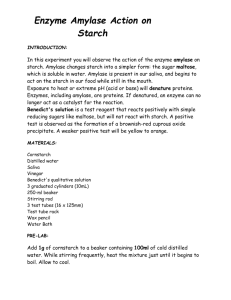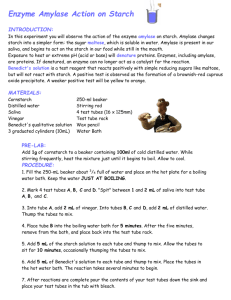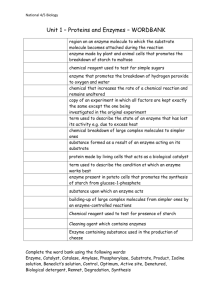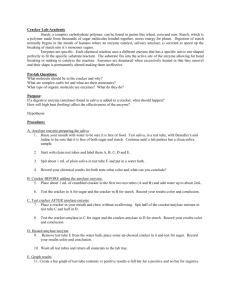Proposal - Patthai.org
advertisement
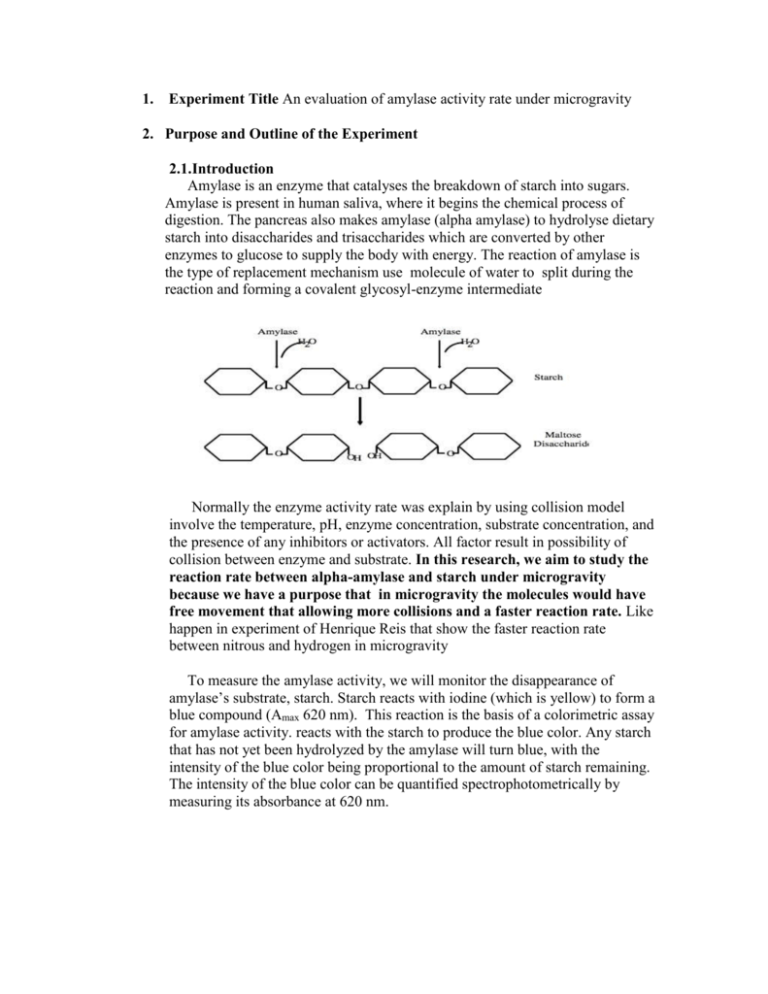
1. Experiment Title An evaluation of amylase activity rate under microgravity 2. Purpose and Outline of the Experiment 2.1.Introduction Amylase is an enzyme that catalyses the breakdown of starch into sugars. Amylase is present in human saliva, where it begins the chemical process of digestion. The pancreas also makes amylase (alpha amylase) to hydrolyse dietary starch into disaccharides and trisaccharides which are converted by other enzymes to glucose to supply the body with energy. The reaction of amylase is the type of replacement mechanism use molecule of water to split during the reaction and forming a covalent glycosyl-enzyme intermediate Normally the enzyme activity rate was explain by using collision model involve the temperature, pH, enzyme concentration, substrate concentration, and the presence of any inhibitors or activators. All factor result in possibility of collision between enzyme and substrate. In this research, we aim to study the reaction rate between alpha-amylase and starch under microgravity because we have a purpose that in microgravity the molecules would have free movement that allowing more collisions and a faster reaction rate. Like happen in experiment of Henrique Reis that show the faster reaction rate between nitrous and hydrogen in microgravity To measure the amylase activity, we will monitor the disappearance of amylase’s substrate, starch. Starch reacts with iodine (which is yellow) to form a blue compound (Amax 620 nm). This reaction is the basis of a colorimetric assay for amylase activity. reacts with the starch to produce the blue color. Any starch that has not yet been hydrolyzed by the amylase will turn blue, with the intensity of the blue color being proportional to the amount of starch remaining. The intensity of the blue color can be quantified spectrophotometrically by measuring its absorbance at 620 nm. 2.2. Purpose To accomplish this experiment studying how microgravity effect in reaction rate between amylase and starch that lead to the result of enzyme kinetics model in micrgrogravity 2.3. Hypothesis Gravity dose the effect in collision between enzyme and substrate then reducing of gravity in microgravity would show the difference rate of reaction of enzyme 2.4. Expected result 1. The quantity data of remain starch in the reaction measure by using UV absorption 2. The reaction rate of enzyme measure by using Michaelis–Menten kinetics equation 2.5. Application 1. Understanding of how microgravity effect on enzyme that are important in human metabolism 2. Further understanding on the alternative effect of microgravity on human health 3. Procedure of Experiment 3.1. Experiment design Valve small tube Syringe contain starch Syringe contain enzyme Motor Gear Top view of mechanics design Motor valve Syringe contain starch small tube Syringe contain enzyme test tube Acidic iodine solution Side view of mechanics design The mechanics design of testing tool is separated in to 3 part 1.Pumping system : This part is driving by 2 motors in the each side, that drive gear to push the syringe. In syringe in the left will contain the 10,8,6,4,2,0 ml.of amylase enzyme in room temperature and another side syringe will contain 10 ml. of 0.2%w/v starch . in each side syringe will connect to another side by the small tube that have a valve in the middle. 2.The valve switching system : This part use 1 motor to turn the valve switch on or off when experiment finish we want to stop reaction then the valve will turn on and the gravity will take the mixing solution in to the test tube below Gear 3.The collecting tube : This part is test tube that connect with valve switching system. The test tube is contain 5 µl. of Acidic iodine solution, this solution will stop enzyme activity when the experiment finish in microgravity period the mixing solution of enzyme and substrate will down to the test tube for stop enzyme working and measure the remain starch 3.2. Experiment On ground We will measure the rate of enzyme and substrate by using the testing tool above and the result will measure in spectrophotometer the result is be in 0.1 to 1.0 range. Afterthat we will Determine the change delta Abs per ml of the assay. Divide the D Abs by the total volume of the assay in ml. To figure out the total volume, the reaction rate will calculate by the Michaelis–Menten kinetics equation that is Where: Km = Michaelis constant [s] = substrate concentration In microgravity The system will run by running motor and the solution will pump out from the syringe and mix together in the small tube. After microgravity period finish the solution will pour down in to the test tube by switch on the motor that control valve. And the enzyme activity will stop and the remain starch will react and show the blue colour. When go back to the ground the solution in the test tube will measure in the same process that do on ground. 4. Overview of experiment apparatus Motor valve Syringe contain starch small tube Gear Syringe contain enzyme test tube Acidic iodine solution Side view of mechanics design Valve small tube Syringe contain starch Syringe contain enzyme Motor Gear Top view of mechanics design 5. Category of the research field for the experiment (Chemistry Physics Biology Medical Science and technology Culture Art Others) Biochemistry 6. Estimated size and weight of the experiment apparatus The size is around 30 x 70 x 20 cm. weight about 10 kg. 7. Estimated power supply requirements Alternate AC 110 V under 1 amp. 8. Requested support equipments none 9. Hazardous material used in the experiment none 10. Request to fly aboard the aircraft to conduct the experiment Yes Please answer the following questions Question 1: Where did you learn about this information? (mark all that apply) NSTDA's e-mail service Other (such as, academic society) e-mail service From teachers/instructors/professors etc. From friends or classmates Newspaper and other media

